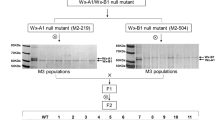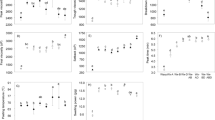Abstract
The Waxy (Wx) protein has been identified as granule-bound starch synthase (GBSS; EC 24.1.21), which is involved in amylose synthesis in plants. Although common wheat (Triticum aestivum L.) has three Wx proteins, “partial waxy mutants” lacking one or two of the three proteins have been found. Using such partial waxy mutants, tetra- and hexaploid waxy mutants with endosperms that are stained red-brown by iodine were produced. Both mutants showed loss of Wx protein and amylose. This is the first demonstration of genetic modification of wheat starch.
Similar content being viewed by others
References
Ainsworth C, Clark J, Balsdon J (1993) Expression, organization and structure of the genes encoding thewaxy protein (granulebound starch synthase) in wheat. Plant Mol Biol 22:67–82
Amano E (1981) Genetic and biochemical characterization of waxy mutants in cereals. Environ Health Perspect 37: 35–41
Briggs RW, Amano E, Smith HH (1965) Genetic recombination with ethyl-methanesulphonate-induced waxy mutants in maize. Nature 207:891–892
Chao S, Sharp PJ, Worland AJ, Warham EJ, Koebner RMD, Gale MD (1989) RFLP-based genetic maps of wheat homoeologous group 7 chromosomes. Theor Appl Genet 78:495–504
Echt CS, Schwartz D (1981) Evidence for the inclusion of controlling elements within the structural gene at thewaxy locus in maize. Genetics 99:275–284
Galili G, Feldman M (1984) Intergenomic suppression of endosperm protein genes in common wheat. Can J Genet Cytol 26:651–656
Hart GH (1987) Genetic and biochemical studies of enzymes. In: Heyne EG (ed) Wheat and wheat improvement. American Society of Agronomy, Madison, Wisconsin, pp 199–214
Hovenkamp-Hermelink JHM, Jacobsen E, Ponstein AS, Visser RGF, Vos-Scheperkeuter GH, Bijmolt EW, de Vries JN, Witholt B, Feenstra WJ (1987) Isolation of an amylose-free starch mutant of the potato (Solanum tuberosum L.). Theor Appl Genet 75:217–221
Kanzaki K, Noda K (1988) Glutinous (Waxy) endosperm starch mutant ofTriticum monococcum L. Jpn J Breed 38:423–427
Kerber ER (1964) Wheat: reconstitution of tetraploid component (AABB) of hexaploid wheat. Science 143:253–255
Kerber ER, Green GJ (1980) Suppression of stem rust resistance in the hexaploid wheat cv. Canthatch by chromosome 7LD. Can J Bot 58:1347–1350
Konishi Y, Nojima Y, Okuno K, Asaoka M, Fuwa H (1985) Characterization of starch granules from waxy, nonwaxy, and hybrid seeds ofAmaranthus hypochondriacus L. Agric Biol Chem 49:1965–1971
Laemmli UK (1970) Cleavage of structural proteins during the assembly of the head of bacteriophage T4. Nature 227: 680–685
Lazzeri PA, Shewry PR (1993) Biotechnology of cereals. In: Tombs MP (ed) Biotechnology and genetic engineering reviews, vol 11. Intercept, Andover, pp 79–146
Mackey J (1954) Neutron and X-ray experiments in wheat and a revision of the speltoid problem. Hereditas 40:65–180
Müller-Röber B, Koßmann J (1995) Approaches to influence starch quantity and starch quality in transgenic plants. Plant Cell Environ 17:601–613
Nakamura T, Yamamori M, Hirano H, Hidaka S (1993a) The waxy (Wx) protein of maize, rice and barley. Phytochemistry 33:749–753
Nakamura T, Yamamori M, Hirano H, Hidaka S (1993b) Identification of three Wx proteins in wheat (Triticum aestivum L.). Biochem Genet 31:75–86
Nakamura T, Yamamori M, Hirano H, Hidaka S (1993c) Decrease of waxy (Wx) protein in two common wheat cultivars with low amylose content. Plant Breed 111:99–105
Nakamura T, Hayakawa K, Yamamori M, Noda K, Hidaka S (1994) Size variation ofWx genes in wheat mutants lacking Wx protein (in Japanese). Jpn J Breed 44(Suppl I): 259
Okagaki RJ, Wessler SR (1988) Comparison of non-mutant and mutant waxy genes in rice and maize. Genetics 120:1137–1143
Preiss J (1991) Biology and molecular biology of starch synthesis and its regulation. In: Miflin BJ (ed) Oxford surveys of plant molecular and cell biology, vol 7. Oxford University Press, Oxford, pp 59–114
Sano Y (1984) Differential regulation ofwaxy gene expression in rice endosperm. Theor Appl Genet 68:467–473
Sears ER (1972) The nature of mutation in hexaploid wheat. Symp Biol Hung 12:73–82
Shannon JC, Garwood DL (1984) Genetics and physiology of starch development. In: Whistler RL, BeMiller JN, Paschall EF (eds) Starch: chemistry and technology, 2nd edn. Academic Press, Orlands, pp 25–86
Shimada H, Tada Y, Kawasaki T, Fujimura T (1993) Antisense regulation of the ricewaxy gene expression using a PCR-amplified fragment of the rice genome reduces the amylose content in grain starch. Theor Appl Genet 86:665–672
Smith AM, Martin C (1993) Starch biosynthesis and the potential for its manipulation. In: Grierson D (ed) Biosynthesis and manipulation of plant products. Plant biotechnology, vol 3. Blackie Academic and Professional, Glasgow, pp 1–54
Vasil V, Castillo AM, Fromm ME, Vasil IK (1992) Herbicide resistant fertile transgenic wheat plants obtained by microprojectile bombardment of regenerable embryogenic callus. Bio/Technology 10:667–675
Visser RGF, Jacobsen E (1993) Toward modifying plants for altered starch content and composition. Trends Biotech 11: 63–68
Visser RFG, Somhort I, Kuipers GJ, Ruys NJ, Feenstra WJ, Jacobsen E (1991) Inhibition of the expression of the gene for granule-bound starch synthase in potato by antisense constructs. Mol Gel Genet 225:296–298
Vos-Scheperkeuter GH, de Boer W, Visser RGF, Feenstra WJ, Witholt B (1986) Identification of granule-bound starch synthase in potato tubers. Plant Physiol 82:411–416
Watson SA (1988) Marketing, processing, and utilization. In: Sprague GF, Dudley JW (eds) Corn and corn improvement, 3rd edition. American Society of Agronomy, Madison, pp 883–940
Weeks JT, Anderson OD, Blechl AE (1993) Rapid production of multiple independent lines of fertile transgenic wheat. Plant Physiol 102:1077–1084
Wessler SR, Varagona MJ (1985) Molecular basis of mutations at thewaxy locus of maize: correlation with the fine structure genetic map. Proc Natl Acad Sci USA 82:4177–4181
Yamamori M, Nakamura M, Kuroda A (1992) Variation in the content of starch-granule bound (Wx) protein among several Japanese cultivars of common wheat (Triticum aestivum L.). Euphytica 64:215–219
Yamamori M, Nakamura T, Endo TR, Nagamine T (1994) Waxy protein deficinecy and chromosomal location of coding genes in common wheat. Theor Appl Genet 89:179–184
Author information
Authors and Affiliations
Additional information
Communicated by H. Saedler
Rights and permissions
About this article
Cite this article
Nakamura, T., Yamamori, M., Hirano, H. et al. Production of waxy (amylose-free) wheats. Molec. Gen. Genet. 248, 253–259 (1995). https://doi.org/10.1007/BF02191591
Received:
Accepted:
Issue Date:
DOI: https://doi.org/10.1007/BF02191591




